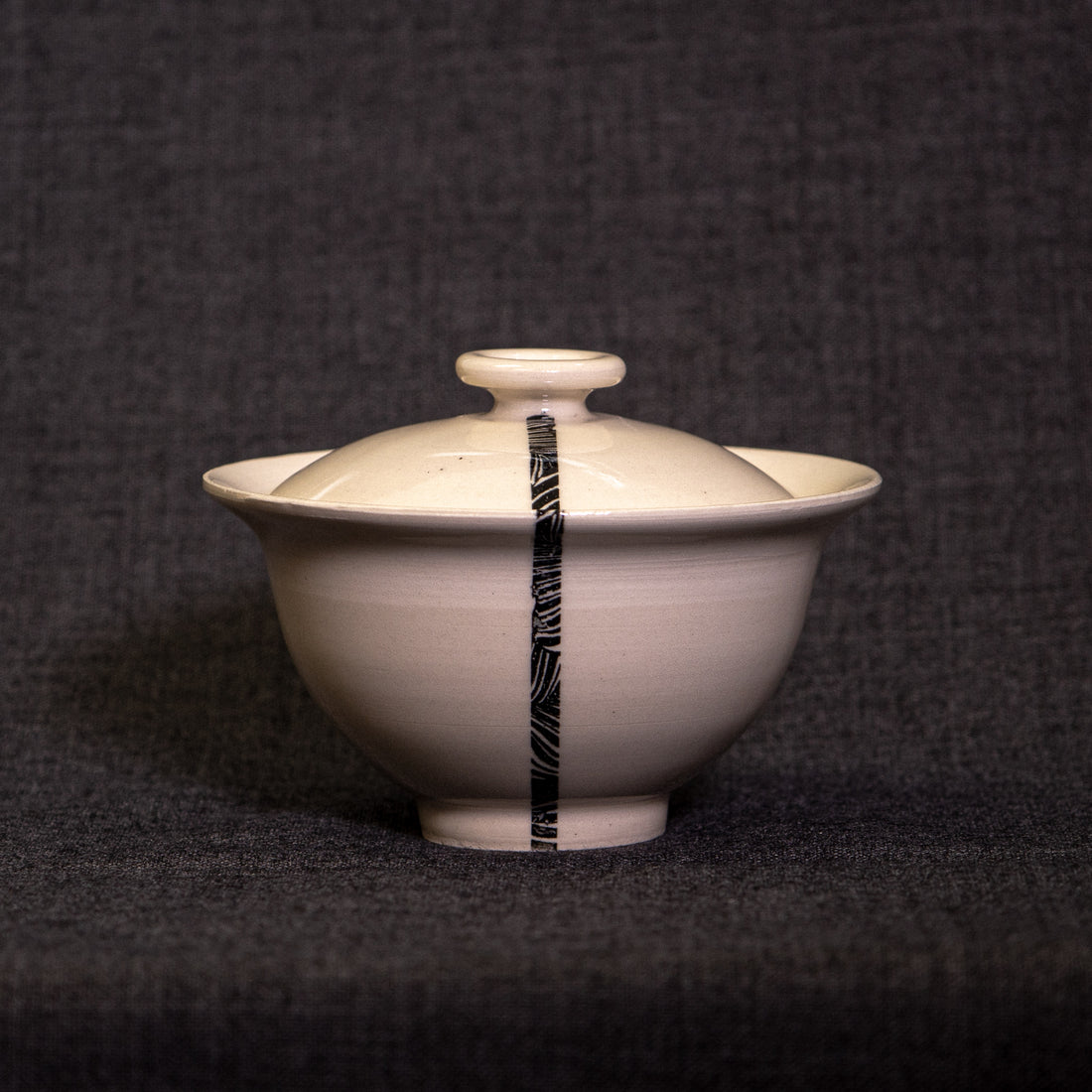
Gong Fu Cha 101: How to Brew Tea in a Gaiwan
If you are a seasoned loose leaf tea drinker but are new to Chinese teas, you may be also be new to using a gaiwan. If you've never brewed a tea using a gaiwan before, it might seem intimidating, but with a little practice it will become old hat in no time.
For all you seasoned gong fu brewers, get out of here! You already know this stuff!!! (But feel free to pass this on to your sibling/cousin/parent/boss or anyone you are trying to lure into the tea life.)

What is a gaiwan?
A gaiwan (literal translation, 'cup with lid') is a brewing vessel you can use to make tea instead of using a teapot. It can range in size from the very tiny, little more than 1oz, to somewhat larger - 150-200ml or so. They don't tend to get much bigger, as the diameter needs to be such that it can be picked up comfortably.
That having been said, everybody's hands are different, and gaiwans come in different sizes and proportions so definitely there's something to be said for finding proportions that suit you personally. Same thing goes for appearance - pick something that appeals to you personally!
A gaiwan is the perfect tool for brewing tea in the 'gong fu cha' style of brewing short infusions with less water over more leaf, such as 6g in a 100ml vessel. We are working on another post that we will link here for a brief overview on 'Gong fu cha' - basic setup and concept. For now, read on for some basic gaiwan tips.
How to brew tea with a gaiwan
1. Weigh out your tea
Many kitchen scales have a hard time weighing amounts under 10g at a time, let alone fractions. You may want to get a decent digital scale that can handle fractions of a gram. Specialty cooking stores, or sometimes specialty coffee shops often sell these. However, it's not strictly necessary to get you brewing.

Don't have a scale, or don't want to buy a scale?
Option 1, DON'T WEIGH THE TEA.
I know, I know, we just said weigh the tea...
Downsides to not weighing - you may be unhappy with the strength of the brew. Ok, no biggie, just remember to use less or more next time. Also, it will be hard to replicate the experience if you feel like you got it just right.
There are many styles of processing and pressing teas, not to mention different sizes of leaf, so it can be tricky to eyeball the weight of your tea. But, the worst thing that can happen is your tea will be too strong or too weak. Not too bad.
Option 2, BREW A MINI!
Lots of tea companies sell handy coins or 'dragonballs' of tea, usually in the 7g range. Perfect size for many gaiwans or pots.

2. Brew time. 1st steep - 'the rinse'
Pour boiling water on top of tea, place lid on gaiwan, and basically immediately pour it back out. Don't rush, don't stress, but no need to wait.

> Pro tip: don't fill the gaiwan to the very top - or stop at the point where the bowl starts to flare out. This way it won't get too hot to hold! This is really important as your steeps get longer as well - the gaiwan will get hotter!
How to pour?
When you're ready, crack the lid ajar, grip the gaiwan by the edges, and pour, into a small pitcher ideally, or straight into your cup if just brewing for yourself.

Many people use their thumb and fourth finger to hold the sides, and their index finger or knuckle to hold the lid in place. You can see what feels comfortable by practicing on an empty gaiwan, or with cold water.
> Truly pro tip, you can also grab the gaiwan by the bottom (not shown) - thumb on top of the lid, rest of your fingers cradling the bottom. Again, grip the foot or edge of the gaiwan bottom, not the bowl itself, as that will be too hot to hold. Much easier to pour, but a bit awkward to initially pick up. (You can use your other hand to help, or if the gaiwan came with a saucer, you can kind of just slip your hand under the saucer, thumb holding the lid in place. This works on bigger gaiwans especially.)
If it feels precarious to make this tipping motion, simply think of it as turning the gaiwan on its side and waiting - you're not so much pouring as you're letting the tea do the work by pouring out.
Your first steeps will generally be very quick, pouring water on and immediately off the leaves, then gradually lengthening steep times to taste. It is an intuitive process you will develop a feel for as you taste each infusion and think about how you might change it next time.
Glass pitcher - 'Cha Hai' or 'Gong dao bei'
Why pour the tea into a pitcher?
- so you can look at the tea's colour
- so the tea is not still steeping while you are trying to serve
- so your guests can see the tea, and see that you are distributing it fairly ('gong dao bei' translates to 'fairness cup' / 'fair cup')

If you're just casually brewing for yourself, you can pour the tea straight into your own cup. This is especially satisfying when you have a cup with the matching volume of your gaiwan - perfect fit. :)
Keep the lid off in between steeps so your tea has room to breathe.
3. Keep brewing - for as long as you want to

As you brew more and more steeps, your leaves will keep expanding. When you're brewing, i.e. when you've poured the water in, you can use the edge of the lid to gently stir or nudge the leaves around to help them expand, and to ensure they're not stuck in the same place from steep to steep.

Hot water in -- nudge leaves -- lid on -- nudge lid open -- grip -- tip

Why would I want to use a gaiwan?
- It's easy to get visual feedback about your tea - you can see the leaves clearly, and especially if your gaiwan is white or a light colour, you can get a sneak preview of the colour of the extraction
- Gaiwans are usually glazed - so you can use them with any style of tea
- Control over your steep times - because you can adjust the position of the lid and the opening the tea pours through, it usually pours off the leaves quickly, whereas some teapots can pour a little more slowly due to spout size or leaf size blocking the tea's exit
- Because gaiwans are beautiful and you want to own one! (Let's be honest, you will not stop at one)
We sell an assortment of gaiwans - a simple yet classic, affordable Celadon gaiwan to get you started, a classy looking ruyao glazed one that will literally show its cracks with age, as well as an assortment of handmade gaiwans by ceramicist Dustin Ryan Yu, made just for us. Dustin specializes in vessels for coffee and tea, and his work is a beautiful example of the aesthetic merits of gong fu teaware.
Note on our 'authority' or perspective:
We are not experts in Chinese culture, Chinese tea, Gong fu cha, or tea history. We are simply enthusiastic tea drinkers, (white settlers located on the unceded Coast Salish territory in the country we colonially call 'Canada'), who want to make this style of tea brewing accessible and easy to enjoy.
We are grateful to have been welcomed to explore brewing tea in this way at various points in our tea drinking journeys - shout outs to Daniel at the Chinese Tea Shop, Olivia at Treasure Green, and Ayden at KUURA for leading us down our tea drinking paths at various points.
We will do a follow up post with more thoughts and suggestions on how you might approach gong fu cha brewing yourself. In the meantime you can also check out this great video from Olivia at Treasure Green demonstrating how to brew using a gaiwan.
Gong fu brewing is a rewarding journey that never stops being refined through practice. Thanks for reading, and happy brewing!
